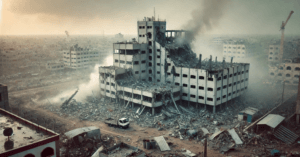Israeli Airstrike Hits Gaza Hospital as Death Toll Surpasses 50,000
More than 50,000 people have been killed in Gaza since the Israel-Hamas war began, with over half reported as women and children. An Israeli airstrike on Nasser Hospital killed five people, including Hamas official Ismail Barhoum. Another strike in Khan Younis killed senior Hamas leader Salah al-Bardaweel and his wife. Heavy airstrikes hit multiple areas overnight, killing at least 30 more Palestinians. Thousands in Rafah have been ordered to evacuate amid intense shelling. The war began on October 7, 2023, after Hamas attacked Israel, killing 1,200 and taking hostages.
Israel launched a large-scale offensive in response. A ceasefire that started in January ended last week, with both sides blaming each other. Efforts to negotiate a new ceasefire remain uncertain. Protests continue in Israel over Prime Minister Netanyahu’s handling of the war and hostages.

Israeli Airstrike Hits Gaza Hospital as Death Toll Surpasses 50,000
The Gaza Health Ministry reports that more than 50,000 people have been killed since the war between Israel and Hamas began in October 2023. The casualties include both civilians and combatants, with officials stating that more than half of the victims are women and children. The conflict has intensified in recent days, with devastating airstrikes hitting key locations and displacing thousands.
Hospital Strike Kills Hamas Official
On Sunday, Israeli forces bombed Nasser Hospital, the largest medical center in southern Gaza, killing five people. Among the dead was Ismail Barhoum, a senior Hamas political leader, who was reportedly recovering from injuries sustained in a previous attack. Israeli Defense Minister Israel Katz confirmed that Barhoum was the intended target, accusing Hamas of using hospitals, schools, and shelters as operational bases—a claim Hamas denies. The strike has heightened concerns about the safety of civilians seeking refuge in medical facilities.
Senior Hamas Leader Killed in Separate Attack
A few days earlier, an Israeli airstrike in Khan Younis killed Salah al-Bardaweel, a prominent Hamas political figure, along with his wife and others. Hamas hailed al-Bardaweel as a dedicated leader, while Israel labeled him a “senior terrorist,” asserting that his death weakened the group’s military capabilities. This attack underscores Israel’s strategy of targeting Hamas officials, even as civilian casualties continue to rise.
Widespread Bombing and Civilian Suffering
Overnight airstrikes hit northern, central, and southern Gaza, with hospitals in the region reporting at least 30 additional deaths in Rafah and Khan Younis on Sunday. Among the victims were women and children, underscoring the war’s devastating impact on civilians. In Rafah, where many displaced families had sought shelter, residents described fleeing under heavy bombardment after being ordered to evacuate. Many escaped with only the clothes they were wearing, leaving behind food, blankets, and other essential supplies.
Origins of the Conflict
The war began on October 7, 2023, when Hamas militants launched a surprise attack in Israel, killing approximately 1,200 people and taking around 250 hostages. Israel responded with a large-scale military offensive in Gaza, vowing to dismantle Hamas. The ongoing campaign has left entire neighborhoods in ruins and triggered a humanitarian crisis, with severe shortages of food, water, and medical supplies.
Ceasefire Collapses Amid Mutual Accusations
A temporary ceasefire that had been in place since January 19 ended last week as Israel resumed intense airstrikes. Israel accused Hamas of violating the truce, while Hamas blamed Israel for reigniting hostilities. Efforts to broker a new ceasefire, led by the United States, have stalled, leaving little hope for an immediate resolution.
Domestic Pressure on Netanyahu
In Israel, frustration is mounting over Prime Minister Benjamin Netanyahu’s handling of the hostage crisis and internal political disputes. Protesters demand stronger efforts to secure the release of remaining captives, criticizing the government’s reliance on military strategies over diplomatic solutions.
Humanitarian Crisis Worsens
As the violence escalates, Gaza’s 2.3 million residents are enduring increasingly dire conditions. Over 85% of the population has been displaced, with many seeking shelter in overcrowded tents or damaged buildings. Aid organizations warn of disease outbreaks and starvation as border crossings remain blocked, restricting access to critical supplies.
International Calls for Peace
Global leaders continue to urge restraint, but divisions persist. The U.S. maintains its support for Israel’s right to self-defense while calling for increased civilian protections. Meanwhile, Arab nations and humanitarian groups are pushing for an immediate ceasefire and expanded humanitarian aid access.
With both sides entrenched in their positions, the war shows no signs of ending. For Gaza’s civilians, each day brings new fears of airstrikes, loss, and an uncertain future. As the death toll continues to climb, the world watches anxiously, hoping for a breakthrough that prioritizes human lives over prolonged conflict.
You must be logged in to post a comment.